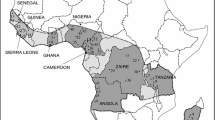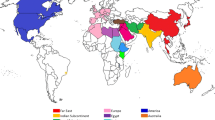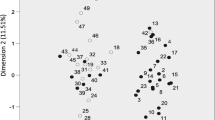Abstract
Amplified fragment length polymorphism (AFLP) analysis was used to assess genetic inter-relationships among olive varieties cultivated in the Eastern Mediterranean Basin. The genotypes sampled included most of the important cultivars from Turkey, Greece and the Middle East and selected genotypes from the Western Mediterranean area. A total of 119 polymorphic markers were generated from five selective primer-pair combinations. The combined data sets generated by just two primer-pairs were adequate to discriminate between all 65 genotypes, while each primer-pair could individually identify up to 64 genotypes. A factorial correspondence analysis (FCA) plot indicated that the cultivars clustered into two relatively modestly defined groups. The first broad group was dominated by cultivars from Turkey but also included genotypes originating from the Middle East (Syria and Lebanon) that collectively formed a tight subcluster. The second group comprised Greek cultivars and those originating from the Western Mediterranean. A significant genetic distance value between Greek and Turkish cultivars was provided by an analysis of molecular variance (amova). There was also evidence of substructure here, with an apparent separation of most Spanish and Italian clones. These findings are in general accordance to previous suggestions of an East-West divergence of olive cultivars, although the dichotomy is less extensive than reported previously and complicated by regional variation within each group.


Similar content being viewed by others
References
Angiolillo A, Mencuccini M, Baldoni L (1999) Olive genetic diversity assessed using amplified fragment length polymorphisms. Theor Appl Genet 98:411–421
Banilas G, Minas J, Gregoriou C, Demoliou C, Kourti A, Hatzopoulos P (2003) Genetic diversity among accessions of an ancient olive variety of Cyprus. Genome 46:370–376
Bassam BJ, Caetano-Anollés G, Gresshoff PM (1991) Fast and sensitive silver staining of DNA in polyacrylamide gels. Anal Biochem 196:80–83
Belaj A, Trujillo I, De la Rosa R, Rallo L, Giménez MJ (2001) Polymorphism and discrimination capacity of randomly amplified polymorphic markers in an olive germplasm bank. J Am Soc Hortic Sci 126:64–71
Belaj A, Satovic Z, Rallo L, Trujillo I (2002) Genetic diversity and relationships in olive (Olea europaea L.) germplasm collections as determined by randomly amplified polymorphic DNA. Theor Appl Genet 105:638–644
Belaj A, Satovic Z, Cipriani G, Baldoni L, Testolin R, Rallo L, Trujillo I (2003a) Comparative study of the discriminating capacity of RAPD, AFLP and SSR markers and their effectiveness in establishing genetic relationships in olive. Theor Appl Genet 107:736–744
Belaj A, Satovic Z, Ismaili H, Panajoti D, Rallo L, Trujillo I (2003b) RAPD genetic diversity of Albanian olive germplasm and its relationships with other Mediterranean countries. Euphytica 130:387–395
Benzécri JP (1982) L’analyse des données, vol II. L’ analyse des correspondances. Dunod, Paris
Besnard G, Bervillé A (2000) Multiple origins for the Mediterranean olive (Olea europaea L.) based upon mitochondrial DNA polymorphisms. C R Acad Sci Paris Ser III 323:173–181
Besnard G, Baradat P, Bervillé A (2001) Genetic relationships in the olive (Olea europaea L.) reflect multilocal selection of cultivars. Theor Appl Genet 102:251–258
Besnard G, Khadari B, Baradat P, Bervillé A (2002a) Olea europaea (Oleaceae) phylogeography based on chloroplast DNA polymorphism. Theor Appl Genet 104:1353–1361
Besnard G, Khadari B, Baradat P, Bervillé A (2002b) Combination of chloroplast and mitochondrial DNA polymorphisms to study cytoplasm genetic differentiation in the olive (Olea europaea L.) complex. Theor Appl Genet 105:139–144
Blondel J, Aronson J (1995) Biodiversity and ecosystem function in the Mediterranean Basin: human and non-human determinants. In: Davis GW, Richardson DM (eds) Mediterranean-type ecosystems (The function of biodiversity). Springer, Berlin Heidelberg New York, pp 43–119
Bronzini de Caraffa V, Maury J, Gambotti C, Breton C, Bervillé A, Giannettini J (2002) Mitochondrial DNA variation and RAPD mark oleasters, olive and feral olive from Western and Eastern Mediterranean. Theor Appl Genet 104:1209–1216
Cipriani G, Marrazzo MT, Marconi R, Cimato A, Testolin R (2002) Microsatellite markers isolated in olive (Olea europaea L.) are suitable for individual fingerprinting and reveal polymorphism within ancient cultivars. Theor Appl Genet 104:223–228
Contento A, Ceccarelli M, Gelati MT, Maggini F, Baldoni L, Cionini PG (2002) Diversity of Olea genotypes and the origin of cultivated olives. Theor Appl Genet 104:1229–1238
Dice LR (1945) Measures of the amount of ecological association between species. Ecology 26:297–302
Excoffier L, Smouse PE, Quattro JM (1992) Analysis of molecular variance inferred from metric distances among DNA haplotypes: application to human mitochondrial DNA restriction data. Genetics 131:479–491
Fabbri A, Hormaza JI, Polito VS (1995) Random amplified polymorphic DNA analysis of olive (Olea europaea L.) cultivars. J Am Soc Hortic Sci 120:538–542
Hatzopoulos P, Banilas G, Giannoulia K, Gazis F, Nikoloudakis N, Milioni D, and Haralampidis K (2002) Breeding, molecular markers and molecular biology of the olive tree. Eur J Lipid Sci Technol 104:574–586
Loukas M, Krimbas CB (1983) History of olive cultivars based on their genetic distances. J Hortic Sci 58:121–127
Lumaret R, Amane M, Ouazzani N, Baldoni L, Debain C (2000) Chloroplast DNA variation in the cultivated and wild olive taxa of the genus Olea. Theor Appl Genet 101:547–553
Mantel NA (1967) The detection of disease clustering and a generalized regression approach. Cancer Res 27:209–220
Nikoloudakis N, Banilas G, Metzidakis J, Gazis F, Hatzopoulos P (2003) Discrimination and genetic diversity among cultivated olives of Greece using RAPD markers. J Am Soc Hortic Sci 128:741–746
Ouazzani N, Lumaret R, Villemur P, Di Giusto F (1993) Leaf allozyme variation in cultivated and wild olive trees (Olea euroeaea L). J Hered 84:34–42
Rohlf FJ (1998) ntsys-pc. Numerical taxonomy and multivariate analysis system, ver. 2.00. Exeter Software, Setauker
Rosa R la, Angiolillo A, Guerrero C, Pellegrini M, Rallo L, Besnard G, Berville A, Martin A, Baldoni L (2003) A first linkage map of olive (Olea europaea L.) cultivars using RAPD, AFLP, RFLP and SSR markers. Theor Appl Genet 106:1273–1282
Saghai-Maroof MA, Soliman KM, Jorgensen RA, Allard RW (1984) Ribosomal DNA spacer length polymorphisms in barley: Mendelian inheritance, chromosomal location and population dynamics. Proc Natl Acad Sci USA 81:8014–8018
Sanz-Cortés F, Badenes ML, Paz S, Ïñiguez A, Llácer G (2001) Molecular characterization of olive cultivars using RAPD markers. J Am Soc Hortic Sci 126:7–12
Sanz-Cortés F, Parfitt DE, Remero C, Struss D, Llácer G, Badenes ML (2003) Intraspecific olive diversity assessed with AFLP. Plant Breed 122:173–177
Sensi E, Vignani R, Scali M, Masi E, Cresti M (2003) DNA fingrprinting and genetic relatedness among cultivated varieties of Olea euroeaea L. estimated by AFLP analysis. Sci Hortic 97:379–388
Sneath PHA, Sokal RR (1973) Numerical taxonomy: the principles and practice of numerical classification. W.H. Freeman, San Francisco
Sokal RR, Michener CD (1958) A statistical method for evaluating systematic relationships. Univ Kans Sci Bull 38:1409–1438
Terral J-F, Alonso N, Capdevila RB, Chatti N, Fabre L, Fiorentino G, Marinval P, Jorda GP, Pradat B, Rovira N, Alibert P (2004) Historical biogeography of olive domestication (Olea euroeaea L.) as revealed by geometrical morphometry applied to biological and archaeological material. J Biogeogr 31:63–77
Vos P, Hogers R, Bleeker M, Reijans M, Vande Lee T, Hornes M, Frijters A, Pot J, Peleman J, Kuiper M, Zabeau M (1995) AFLP: a new technique for DNA fingerprinting. Nucleic Acids Res 23:4407–4414
Zohary D, Hopf M (1994) Olive: Olea europaea. Domestication of plants in the Old World. Clarendon Press, Oxford, pp 137–143
Zohary D, Spiegel-Roy P (1975) Beginnings of fruit growing in the Old World. Science 187:319–327
Acknowledgements
The authors would like to thank Dr. Mike Wilkinson for his helpful suggestions during the preparation of the manuscript. This work was supported by the European Union General Directorate I—Centre International des Haute Etudes Agronomiques Mediterranéennes Joint Initiative ‘Collaborative Mediterranean Biotechnology Network (COMBINE)’.
Author information
Authors and Affiliations
Corresponding author
Additional information
Communicated by E. Guiderdoni
Rights and permissions
About this article
Cite this article
Owen, C.A., Bita, EC., Banilas, G. et al. AFLP reveals structural details of genetic diversity within cultivated olive germplasm from the Eastern Mediterranean. Theor Appl Genet 110, 1169–1176 (2005). https://doi.org/10.1007/s00122-004-1861-z
Received:
Accepted:
Published:
Issue Date:
DOI: https://doi.org/10.1007/s00122-004-1861-z




